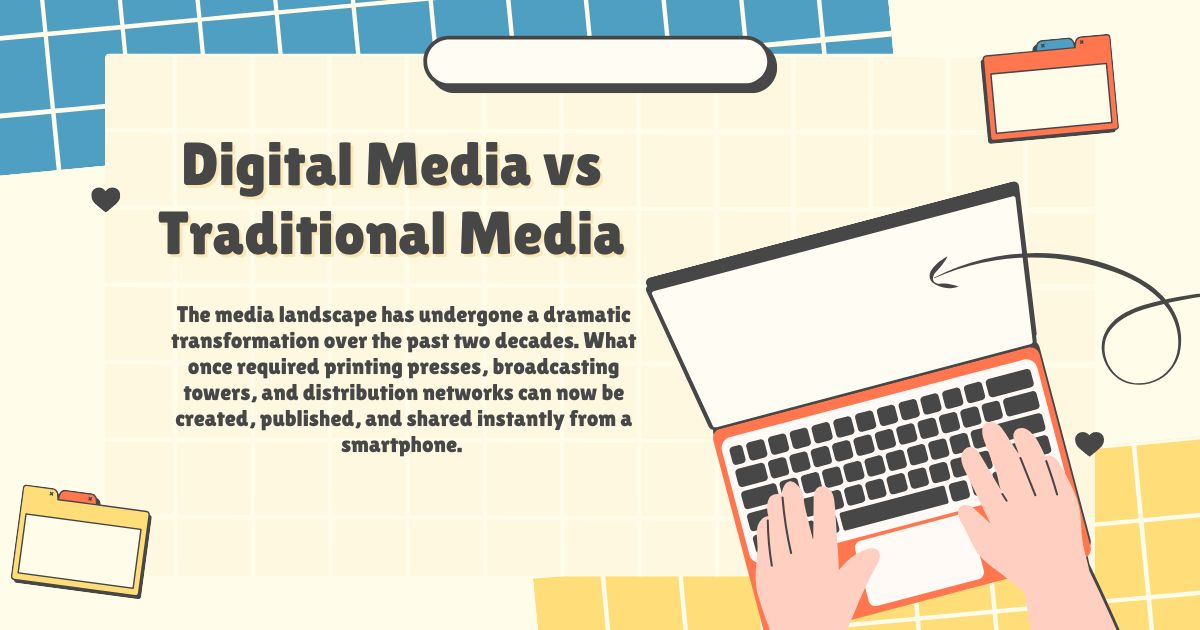
The media landscape has undergone a dramatic transformation over the past two decades. What once required printing presses, broadcasting towers, and distribution networks can now be created, published, and shared instantly from a smartphone. This shift from traditional to digital media has fundamentally altered how we create, consume, and interact with content.
Understanding the differences between digital and traditional media is crucial for anyone involved in marketing, communications, or content creation. While traditional media like newspapers, television, and radio dominated for decades, digital media has introduced new possibilities for targeting, engagement, and measurement that were previously impossible.
This transformation affects more than just how we advertise products or share news. It has changed the very nature of communication, creating opportunities for two-way conversations, real-time feedback, and personalized experiences. For businesses and content creators, recognizing these differences can mean the difference between reaching your audience effectively or getting lost in the noise.
Understanding Traditional Media
Traditional media encompasses the established forms of mass communication that dominated the 20th century. This includes newspapers, magazines, television, radio, billboards, and direct mail. These mediums typically follow a one-way communication model, where content creators broadcast messages to a passive audience.
The hallmarks of traditional media include high production costs, longer lead times, and broad demographic targeting. When a company wanted to advertise on television, they needed substantial budgets and had to commit to campaigns weeks or months in advance. The audience was largely anonymous, and measuring engagement was challenging and imprecise.
Traditional media also operates on scheduled programming and fixed publication dates. Newspapers publish daily, magazines monthly, and television shows air at specific times. This creates a predictable but inflexible content delivery system.
What Are the Main Types of Digital Media?
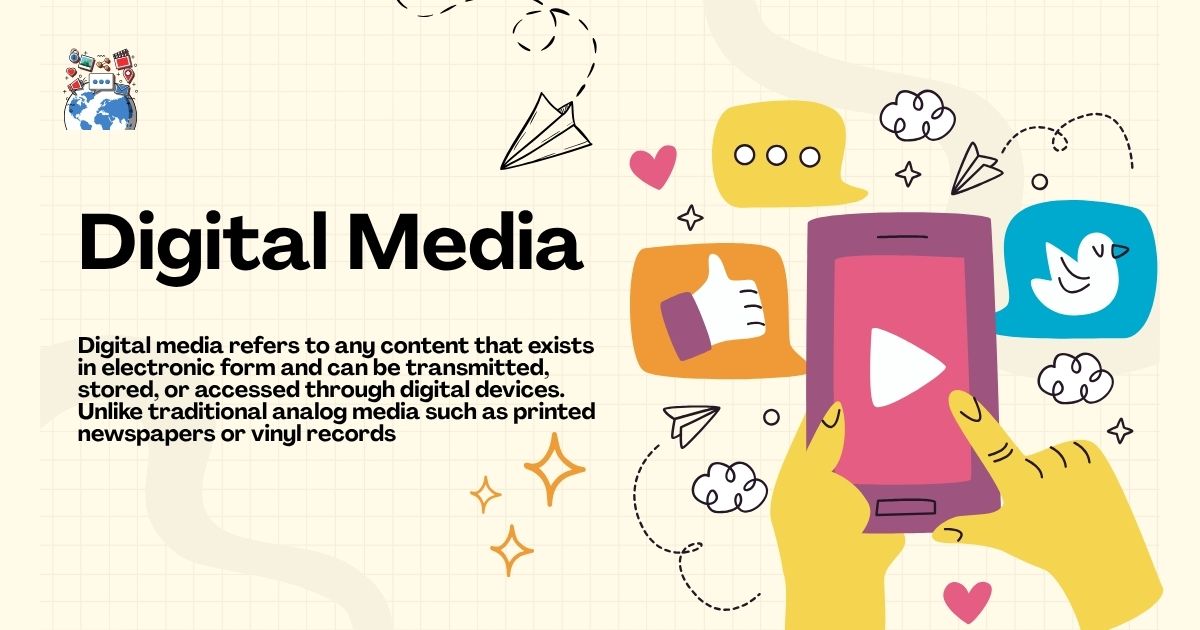
Digital media encompasses any content that exists in electronic format and can be accessed through digital devices. Unlike traditional media, digital media is interactive, easily shareable, and can be updated in real-time.
Social Media Platforms
Social media has revolutionized how we connect and share information. Platforms like Facebook, Instagram, Twitter, LinkedIn, and TikTok allow users to create, share, and interact with content instantly. These platforms have become powerful marketing tools, enabling businesses to build communities, engage directly with customers, and create viral marketing campaigns.
Each platform serves different purposes and demographics. LinkedIn focuses on professional networking, Instagram emphasizes visual content, and TikTok caters to short-form video entertainment. This diversity allows for highly targeted marketing strategies.
Websites and Blogs
Websites serve as digital storefronts and information hubs for businesses and individuals. Unlike traditional brochures or catalogs, websites can be updated instantly, include multimedia content, and provide interactive features like chat support or online purchasing.
Blogs have democratized publishing, allowing anyone to become a content creator and thought leader in their field. They support SEO strategies, help build authority, and create ongoing touchpoints with audiences.
Email Marketing
Email remains one of the most effective digital marketing channels, offering direct access to subscribers’ inboxes. Unlike traditional direct mail, email campaigns can be personalized, automated, and tracked with precise metrics.
Digital Advertising
Digital advertising includes pay-per-click ads, display banners, video ads, and sponsored content across various platforms. These ads can be targeted based on demographics, interests, browsing behavior, and even specific keywords users search for.
Streaming and On-Demand Content
Platforms like YouTube, Netflix, Spotify, and podcasting services have created new content consumption patterns. Users can access content whenever they want, skip advertisements, and receive personalized recommendations based on their preferences.
Mobile Apps
Mobile applications provide dedicated platforms for specific services or content. They offer push notifications, offline functionality, and highly personalized user experiences that traditional media cannot match.
How Has Digital Media Changed the Way We Consume Content?
The shift to digital media has fundamentally altered content consumption patterns in several key ways.
On-Demand Access
Digital media eliminated the constraints of scheduled programming. Users now expect to access content whenever and wherever they want. This has led to the rise of binge-watching, podcast subscriptions, and 24/7 news cycles.
Interactive Engagement
Traditional media was largely passive—you watched, read, or listened. Digital media encourages active participation through comments, shares, likes, and user-generated content. This interactivity has created communities around content and brands.
Personalization
Digital platforms use algorithms and data analytics to deliver personalized content recommendations. Netflix suggests movies based on viewing history, Spotify creates custom playlists, and social media feeds show content tailored to individual interests and behaviors.
Shorter Attention Spans
The abundance of digital content has created a more competitive environment for attention. This has led to shorter content formats, from Twitter’s character limits to TikTok’s quick videos and Instagram Stories.
Multi-Platform Consumption
Users now consume content across multiple devices and platforms simultaneously. They might start watching a video on their phone during commute and finish it on their laptop at home. This requires content creators to optimize for various formats and devices.
User-Generated Content
Digital platforms have empowered users to become content creators themselves. Reviews, social media posts, and user videos now significantly influence purchasing decisions and brand perceptions.
Why Is Digital Media Important in Today’s Marketing Strategy?
Digital media has become essential for modern marketing strategies due to its unique advantages and the changing behavior of consumers.
Precise Targeting and Measurement
Unlike traditional media’s broad demographic targeting, digital media allows for granular audience segmentation. Marketers can target users based on specific interests, behaviors, location, and even life events. Additionally, every interaction can be measured, providing clear ROI data and enabling continuous optimization.
Cost-Effectiveness
Digital marketing campaigns can be launched with much smaller budgets than traditional media campaigns. Small businesses can compete with larger companies by creating compelling content and using targeted advertising on social media platforms.
Real-Time Engagement
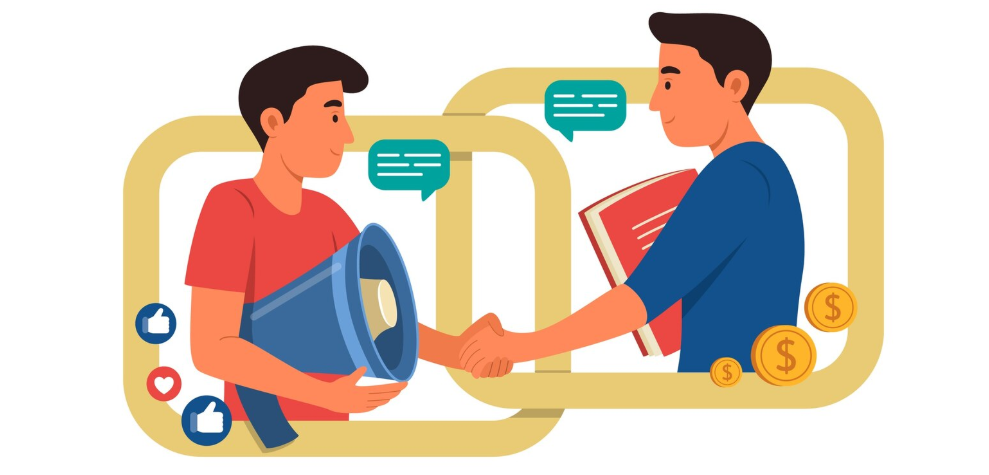
Digital media enables immediate two-way real-time crisis communication between brands and customers. Companies can respond to customer service issues, address concerns, and capitalize on trending topics in real-time.
Global Reach
Digital platforms provide access to global audiences without the geographic limitations of traditional media. A small business can reach customers worldwide through social media, email marketing, and online advertising.
Adaptability and Testing
Digital campaigns can be modified instantly based on performance data. A/B testing allows marketers to optimize messaging, creative elements, and targeting parameters continuously.
Integration Capabilities
Digital media channels can be integrated to create cohesive customer journeys. Email campaigns can drive traffic to websites, social media can amplify blog content, and retargeting ads can re-engage website visitors across multiple platforms.
Content Longevity
Digital content optimization can have a much longer lifespan than traditional media. Blog posts continue to attract readers through search engines years after publication, and social media content can be reshared and rediscovered.
Choosing the Right Media Mix
The most effective influencer marketing strategies often combine both traditional and digital media elements. Traditional media still excels at building broad brand awareness and reaching certain demographics, particularly older audiences who may be less active on digital platforms.
Digital media’s strength lies in its ability to create targeted, measurable, and interactive campaigns that can adapt quickly to changing market conditions. The key is understanding your audience’s media consumption habits and choosing the channels that best reach them.
For many businesses, digital media offers better ROI and more precise targeting, making it an essential component of any modern marketing strategy. However, the most successful campaigns often integrate multiple touchpoints to create comprehensive brand experiences.
Embracing the Digital Future
The distinction between traditional and digital media continues to evolve as technology advances. Connected TV, digital radio, and interactive print advertisements are blurring the lines between these categories.
Understanding these differences empowers businesses and content creators to make informed decisions about where to invest their time and resources. As consumer behavior continues to shift toward digital channels, developing digital media expertise becomes increasingly crucial for success.
The future belongs to those who can effectively leverage digital media’s unique capabilities while understanding how to integrate these efforts with traditional media when appropriate. Start by identifying which digital channels align best with your audience and objectives, then gradually expand your digital presence as you gain experience and see results.















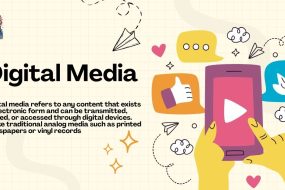
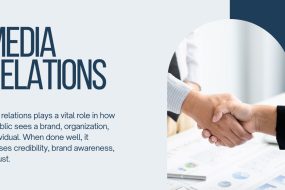
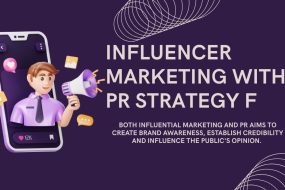

No Comments